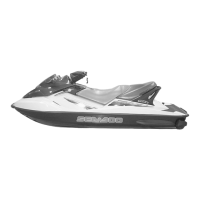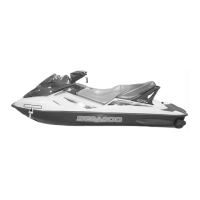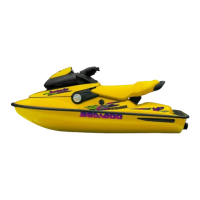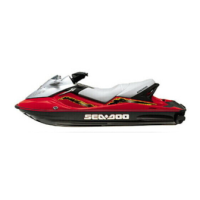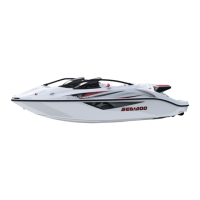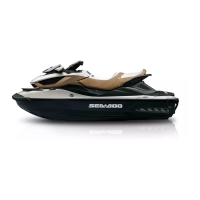Section04ENGINEMANAGEMENT(15034-TEC)
Subsection 01 (OVERVIEW)
Electronic Fuel Injection
The ECM reads the signals from different sensors
which indicate engine operating conditions at milli-
second intervals.
Signals from sensors are used by the ECM to de-
termine the injection parameters (fuel maps) re-
quired for optimum air-fuel ratio.
TheCPS,theMATS,theMAPSandtheTPSare
the primary sensors used to control the injection
and ignition timing. Other sensors (like tempera-
ture sensors, etc.) are used for secondary input.
NOTE: The EGTS, CTS and OPS sensors do not
provide control inputs to the ECM. Their sole pur-
pose is to protect the engine components by emit-
ting a warning signal in the event of overheating or
low oil pressure.
Ignition System
The ignition system is a digital inductive type.
The ECM controls the ignition system param-
eters, such as spark timing, duration and firing
order to achieve the proper engine requirements.
Refer to IGNITION SYSTEM.
Ignition Timing
The ECM is programmed with data (it contains ig-
nition mappings) for optimum ignition timing un-
der all operating conditions. Using engine operat-
ing conditions provided by the sensors, the ECM
controls the ignition timing for optimum engine op-
eration. No adjustment of the ignition timing is re-
quired.
Knock Sensor
A knock sensor is mounted on the cylinder block
behind the intake manifold. It detects specific vi-
bration that would be typically generated by en-
gine detonation. If detonation occurs, the knock
sensor detects it and the ECM retards the ignition
advance temporarily (it goes in a specific mode)
until detonation stops. The ECM is able to evalu-
ate the knocking cylinder and modifies the ignition
advance just on the detonating one.
Ignition Coils
Three separate ignition coils induce voltage to a
high level in the secondary windings to produce a
spark at the spark plug.
The ignition coils receive input from the ECM.
Each coil provides high voltage to its correspond-
ing spark plug.
This ignition system allows spark plugs to spark
independently.
All three ignition coils are located on the cylinder
head directly on the spark plugs.
1
R1503motr213A
TYPICAL
1. Ignition coils
Digitally Encoded Security
System (DESS)
This system allows starting the vehicle only with
safety lanyard(s) that has been programmed to op-
erate a specific watercraft. This functionality is
the DESS system.
NOTE: If desired, a safety lanyard can be used on
other watercraft equipped with the DESS. It only
needs to be programmed for that watercraft.
The DESS circuitry in the ECM is activated at the
factory. Therefore, a safety lanyard must be pro-
grammed to start the engine.
The following components are specially designed
for this system: Multi-Purpose Electronic Module
(MPEM), ECM, safety lanyard cap and safety lan-
yard post.
The safety lanyard cap contains a magnet and a
ROM chip. The magnet actually closes the reed
switch inside the post which is the equivalent
of a mechanical ON/OFF switch. The chip has a
unique digital code.
The system is quite flexible. Up to 8 safety lan-
yards may be programmed in the memory of the
ECM. They can also be erased individually.
smr2005-011 75
